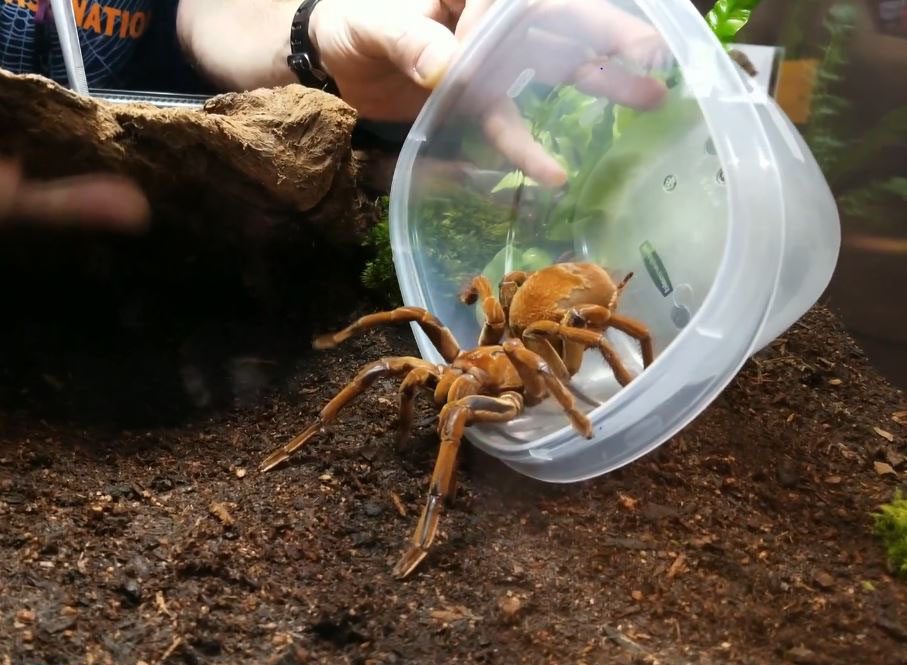
Goliath Birdeater (Theraphosa blondi).(Photo Courtesy Mateus Pepinelli and the Royal Ontario Museum)
The Goliath birdeater is one of the newest additions to the Royal Ontario Museum’s collection of more than 400 species of arachnid. If you’re scared of hairy eight-legged creatures, I’d suggest clicking to a different story!
The birdeater is one of the largest spiders in the world. Its species hails from Brazil’s Amazon rainforest.
This specimen feeds on anything it can sink its fangs into insects, rodents, small lizards, and, according to ROM entomologist Mateus Pepinelli, even small birds. Although he admits that birds aren’t a part of its main diet, the intimidating title actually comes from the enormous size of the spider, which looks large enough to take on just about anything of similar size.
Pepinelli explained that, like all spiders, the Goliath is venomous, but its venom is not particularly effective against humans or larger prey. The Goliath is, like most spiders, an ambush predator. It uses surprise, together with its huge legs covered in spines, and the venom in its fangs, to subdue prey alive. The prey is then stored for later consumption, but only after the venom and doses of saliva turn the prey’s insides to liquid.
The Goliath arrived in September after being purchased from a private seller, according to Pepinelli, and joined the current exhibit entitled “Spiders: Fear and Fascination.” Two other newcomers came along at the same time: a Brazilian wandering spider, and the Deathstalker scorpion, which hails from the Middle East. All three make up the “biggest and baddest” portion of the exhibit, which showcases the most dangerous and the largest spiders in the world.

Vacant Silk Web Display (TAYLOR BRIDGER /TORONTO OBSERVER)
Like most tarantulas, the Goliath birdeater doesn’t feed often, with mealtime consisting of a single Madagascar hissing cockroach (some of the largest in the world). Meals only come around every few months, yet the Goliath may nearly double its current size to a third of a metre wide.
The spider also undergoes a venom milking from time to time. In fact, every resident of the exhibit occasionally is milked for its venom, in front of a live audience. The venom is refrigerated and used to further research into spiders and scorpions and then afterward the creatures are put on “vacation” so that their venom can regenerate, Pepinelli said.
Pepinelli is one of two entomologists who maintain the day to day functions of the exhibit, including handling the spiders. He likes to tell visitors just how much a Goliath tarantula can grow.
“It depends on several factors. When they are adults they molt or shed their exoskeleton. If you pump them full of food they keep growing, but if they are in the wild they probably molt maybe once a year, so you have to wait many years,” he explained. “It will take maybe ten full years to see the Goliath at full size.”
Tarantulas and other large spiders can sometimes live for many years, with the oldest spider recorded in Australia living to 43 years old, he added.
Alan Romanchuk, 38, and his wife Pamela made a date out of the exhibit and saw the Goliath and the exhibit’s other creatures in all their eight-legged glory.
“What I thought was the most interesting was just why they milk the venom, all of the properties that spider venom apparently has, all of the science they can do with the venom they milk is really interesting,” Romanchuck said of the exhibit. “I think the exhibit fits the ROM, I’d definitely go see them milk a different spider, you learn different things about each species when you watch them put the spider to sleep and then milk its fangs.”

Brazilian salmon pink bird-eating tarantula (Lasiodora parahybana). (Photo Courtesy Brian Boyle/ Royal Ontario Museum)
The Goliath isn’t the ROM’s only bird eater. According to Judy Batay, a science journalist and ROM volunteer staff member who mainly works in the biodiversity exhibit, the Brazilian salmon pink birdeater is her personal favourite. Although an older resident of Toronto’s museum, it’s of similar size to the Goliath.
“It’s beautiful, I think its an even more beautiful species than the Goliath. What do you think?” Batay asked.
The ROM exhibit, which ends in January 2019, doesn’t just feature the “biggest,” but also the “baddest.” It also doesn’t just feature spiders, it also features highly venomous scorpions. Visitors can watch daily shows about the ROM’s wide variety of scorpions, including watching the carapace glow in the dark.

